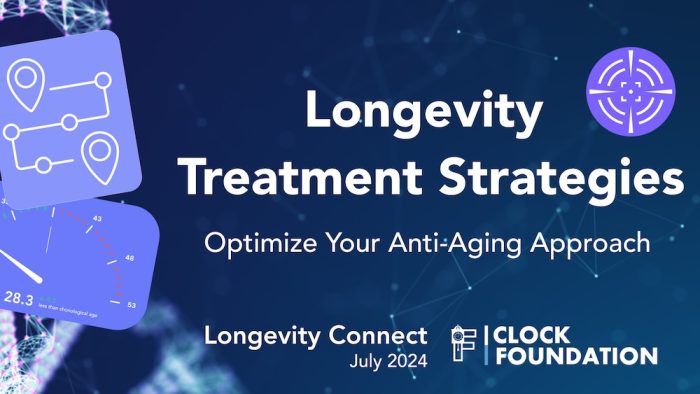On July 25, 2024, Bobby Brooke and Clock Foundation / MyAgingTests.com team hosted another Longevity Connect webinar. The topic was “Longevity Treatment Strategies.”
During the event, Brooke shared an evaluative and science-based summary of longevity treatments available now, what criteria to consider when choosing anti-aging interventions and some best practices for anyone creating or optimizing a longevity action plan.
The webinar boiled down to three questions:
- What can you do to live longer?
- What are some science-backed longevity treatment strategies anyone can take advantage of now?
- What’s on the horizon for longevity research and longevity pursuers based on preclinical animal and mouse studies on aging?
Two key takeaways:
- Value of Small Studies with Large Effect Sizes: One of the key ideas was the value of small studies and trials. While Random Control Trials (RCTs) remain the gold standard for researchers, this approach is costly and time-consuming. You don’t necessarily need hundreds of participants to have an impact on longevity research and enable meaningful longevity choices for longevity pursuers. Specifically, a small trial with a larger effect size can provide meaningful insight into whether a treatment is effective or not.
- Combination Approach: Another important takeaway during the event was potential of combination approach. Unlike a monotherapy that tests a single agent or a shotgun approach that tests dozens of agents, a combination approach aims to develop and test rational combinations of different longevity treatments that are selected based on their complementary effects on aging biology, functional benefits, and disease biomarkers. This approach seeks to maximize the synergistic benefits of the interventions while minimizing potential negative interactions. This is basic idea at the core the Longevity Groups initiative.
Finally, like each monthly event, we conclude with a review of summary from on-going research on epigenetic clocks, biological age testings and longevity research in preclinical and clinical space.
Below is the full recap, citations, summary, and screenshots from the webinar. Hope you enjoy!
Agenda and Table of Contents of Topics Covered
- ???? Longevity Treatment Strategies ????
- Assess Your Epigenetic Aging Risk Factors
- Promising Longevity Interventions Available Today
- Complexity of Human Aging + What To Consider
- Tracking Efficacy of Human Aging Treatments – Which Biomarkers? + What To Consider
- Monotherapy vs Shotgun vs. Combination Approaches
- Longevity Groups: Patient-Led Targeted Combination for Promising Longevity Interventions Available Today
- ⏰ Review of Epigenetic Clock Data Papers
- ???? / ???? Treatment News ????????⚕️
About Us:
Founded by Steve Horvath and Bobby Brooke, the nonprofit Clock Foundation (https://clockfoundation.org) is dedicated to pushing the boundaries of longevity research for tangible improvements in human health and lifespan. We’ve completed over 300 longevity projects in our first 3 years.
Through MyAgingTests.com, we offer cutting-edge biological age testing and a range of longevity services and software solutions for individuals and groups (clinics, researchers and coaches) interested in quantifying aging and managing anti-aging programs, intervention studies and trials.
Learn more at https://clockfoundation.org/get-started/.
Longevity Connect is a Monthly Longevity Science and Anti-Aging Strategies Virtual Meetup, brought to you by Clock Foundation and MyAgingTests.com.
Got questions or interested in joining our next Longevity Connect event? Check our event schedule and signup at https://myagingtests.com/longevity-connect/.
Disclaimer
Disclaimer: Nearly all aging biomarker tests today are “research use only” tests, which means they are not approved by FDA for use in treatment of any diseases. There is no guarantee that even with the best measures of biological or epigenetic age, i.e. epigenetic clocks, that if you reverse it by 5 years it will always translate into 5 extra years of life.
You should always consult your physician before initiating any new treatment.
Conflicts of Interest: I (Bobby Brooke) work with a private biotech company Intervene Immune developing treatments for immune system regeneration. Through Clock Foundation I work as a non-profit collaborator for dozens of aging researchers, including many academics and longevity biotech companies.
For Longevity Connect recaps, we focus on analysis of data that’s already been published, and largely on treatments that are already available for use in clinical trials.
Key Topics: Longevity Connect on July 25, 2024
What can you do to live longer? Assess Your Epigenetic Aging Risk Factors
People often ask us what they should in general to live longer, and while we have come to find more and more evidence towards particular lifestyle choices and longevity inteventions, we still believe in the importance of measuring your biological age and assessing your particular epigenetic aging risk factors.
At the Clock Foundation and MyAgingTests.com, our mission is to enable everyone to achieve longer, healthier lives using safe and affordable interventions. We believe and have shown that epigenetic age testing can improve health risks and should be a key part of an evidence-based approach to navigate and extending human healthspan individually and collectively.
An exciting part of epigenetics is that unlike a genetic test, it’s modifiable. That means an intervention can have an effect on it and you can improve your risk factors through lifestyle changes and anti-aging interventions. Since inception, our group has worked on over 300 academic projects and studies evaluating longevity science and anti-aging effects epigenetic age testing.
The big picture for us as a nonprofit research organization is to ultimately arrive at an understanding of the risk profile for any agent or any any treatment and evaluate its potential benefit for anyone looking to achieve a longer, healthier life. In short, we want to evaluate and identify the best interventions that fit someone’s unique aging risk factors that can extend lifespan and healthspan.
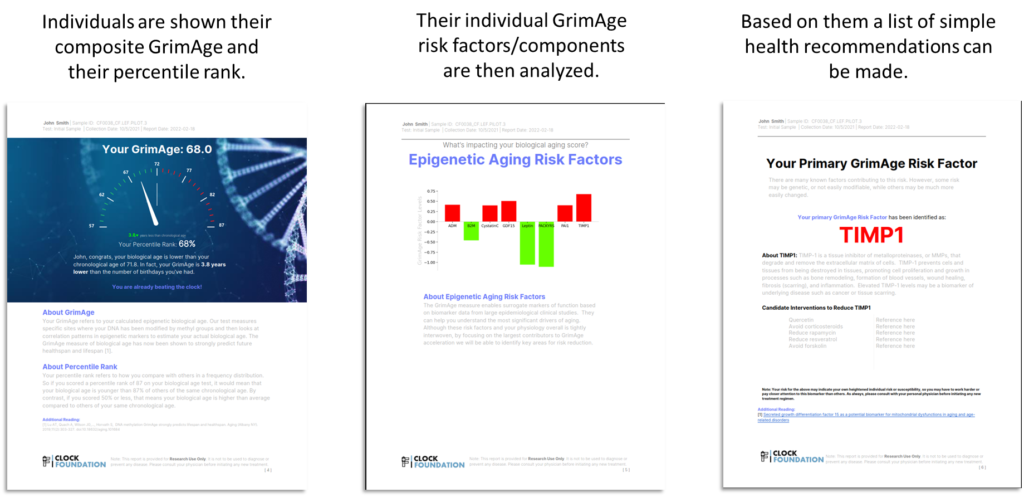
For this reason, with all of our biological age reports, whether GrimAge or PhenoAge, we include candidate interventions. These are different evidence-based recommendations with peer-reviewed references that can be used to improve those risk factors and modify one’s epigenetic age. We include peer-reviewed references to help support the why behind that recommendation and provide additional information for our science-minded members of our community to take action.
Epigenetic testing provides personalized recommendations for treatments and supplements that can help improve your specific risk factors. This allows you to take a more targeted and evidence-based approach to longevity interventions. Tracking changes in your epigenetic age over time can help you evaluate the effectiveness of the longevity treatments and lifestyle changes you implement. This allows you to optimize your strategy for improving your healthspan and lifespan.
Promising Longevity Interventions Available Today
Various supplements, medications, and treatments have shown potential benefits for improving longevity and healthspan.
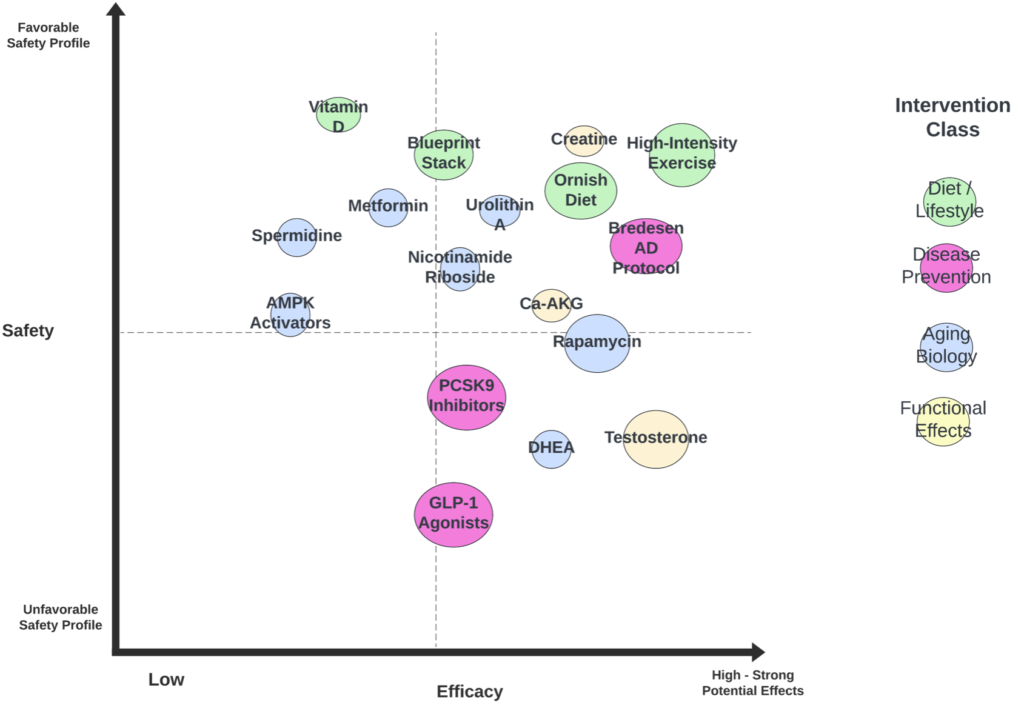
This chart shows how we evaluate risk-benefit or safety-efficacy profile of putative longevity treatments.
Here is a breakdown of different types:
- Novel Supplements: Are Spermidine, AKG, NAD & NAD Precursors, like Nicotinamide Riboside, Urolithin A, and AMPK Activators right for you?
- Longevity Medications: Learn about the potential of medications and pharmaceuticals like Metformin, Acarbose, Rapamycin, Testosterone, PCSK9 Inhibitors, GLP-1 agonists, ACE Inhibitors, and others in extending lifespan.
- Role of Diet and Lifestyle Changes: Explore how lifestyle modifications like the Mediterranean diet, fasting, or the use of Vitamin D can impact epigenetic age (or not), and set you up for success with additional treatments.
- Monotherapy vs Combination vs. Shotgun Approaches: Discussion of single agent testing vs. evaluation of combination or even shotgun approaches, such as the Blueprint Protocol by Bryan Johnson, Bredesen/MIND Protocol for Reversal of Cognitive Decline, etc.
- Targeting the Hallmarks of Aging & Systems Aging Risk Factors: Discover how different treatments aim to address the fundamental processes of aging.
Brooke discussed the different types of evidence available for these interventions, including cell culture studies, preclinical animal studies, and clinical trials. There are many different types of clinical trial designs, too like a pilot study, versus a large RCT where it’s placebo controlled.
Brooke noted his belief in the importance and value of in running relatively small trials. According to him, you don’t need 500 or 1000 people in a trial for it to have an impact on longevity research and for it to provide very convincing evidence, especially as it relates to proving whether a treatment is effective or not. Even a small trial with a larger effect size can produce convincing results.
For this reason, we continue to push forward with our small trial, participatory research approach called Longevity Groups, which aims to bring dozens of participants to help test and evaluate both single agents and combinations of agents.
He also noted that one additional criteria is simply availability. In the United States, Europe and other parts of the world, there are different legal status of certain agents and availability varies from place to place. For example, in the US, DHEA is a supplement you can buy on Amazon, whereas in Europe, it’s largely only available with a doctor’s prescription. Many longevity treatments fall into a “gray zone” as to whether they are a supplement or drug. And its availability might depend on different regulatory framework in Europe, the UK or US.
Intro to Longevity Treatment Strategies
Brooke laid out a framework for introducing and pursuing different longevity treatment strategies. These into several buckets:
- Research Approach: Fundamental vs. Technical Research
- Treatment Approach: Monotherapy vs. Combination vs. Shotgun Approaches
- Biomarkers: Aging Biology vs. Disease Prevention vs. Functional Outcomes
Where do Epigenetic Clocks fit in?
- Research Evidence: In Vitro vs. Preclinical vs. Epidemiology vs. Interventional vs. RCT
When Small Trials Convince
- Type: Small molecule vs. Biologic, Cost, Convenience, Availability
- Timing, Dose & Interaction Effects: Fixed Dose vs. Personalized vs. Adaptive
How long is appropriate, and what cycling is necessary?
In order to properly evaluate and setup a robust and science-based longevity strategy as a group or individual, these are key components to keep in mind. Let’s look at the them one by one as we dive more into the science of aging.
Complexity of Human Aging
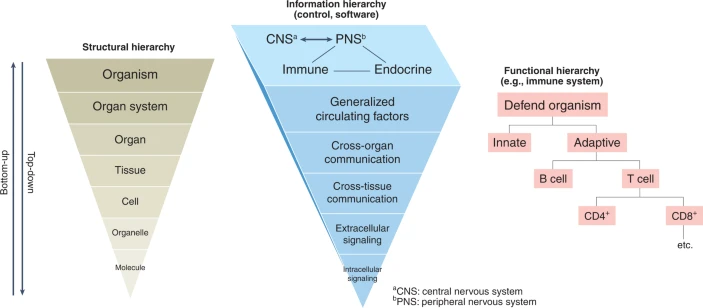
A complex systems approach to aging biology (Cohen et al 2022)
In his discussion on the complexity of human aging, Bobby Brooke emphasized that aging is complex, affecting proteins, cells, tissues, and physiological systems, with resilience and adaptation occurring at multiple levels. He also pointed out the lack of a definitive and shared theory of aging.
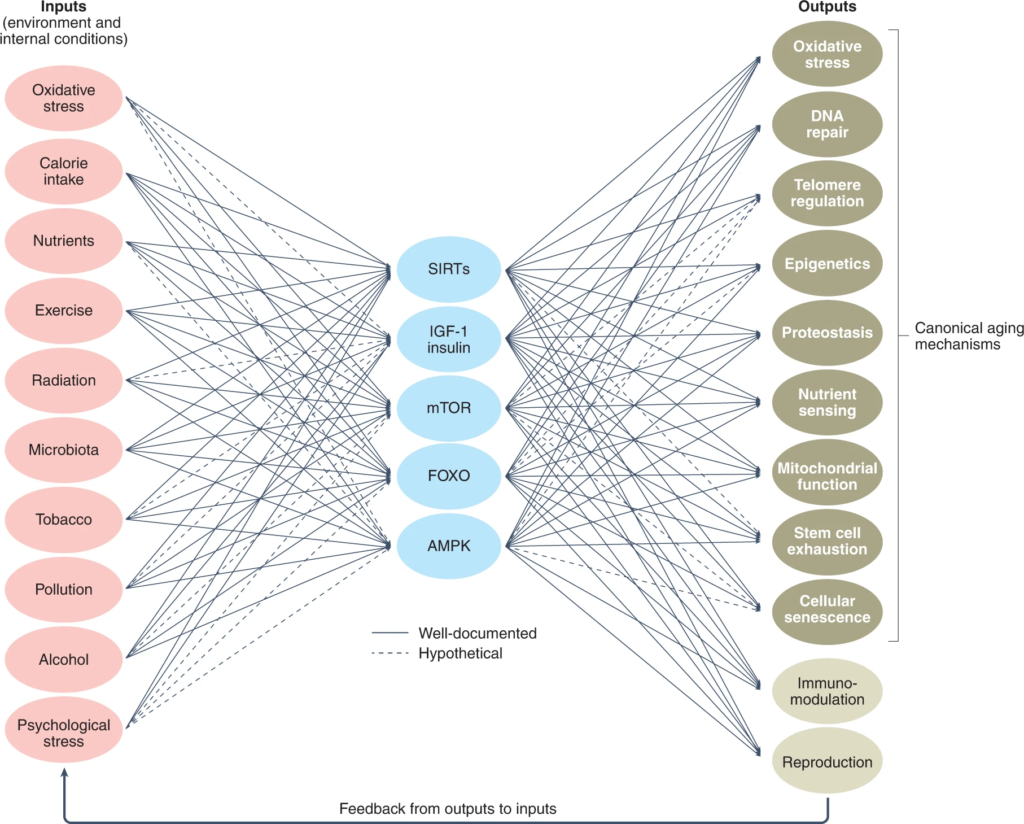
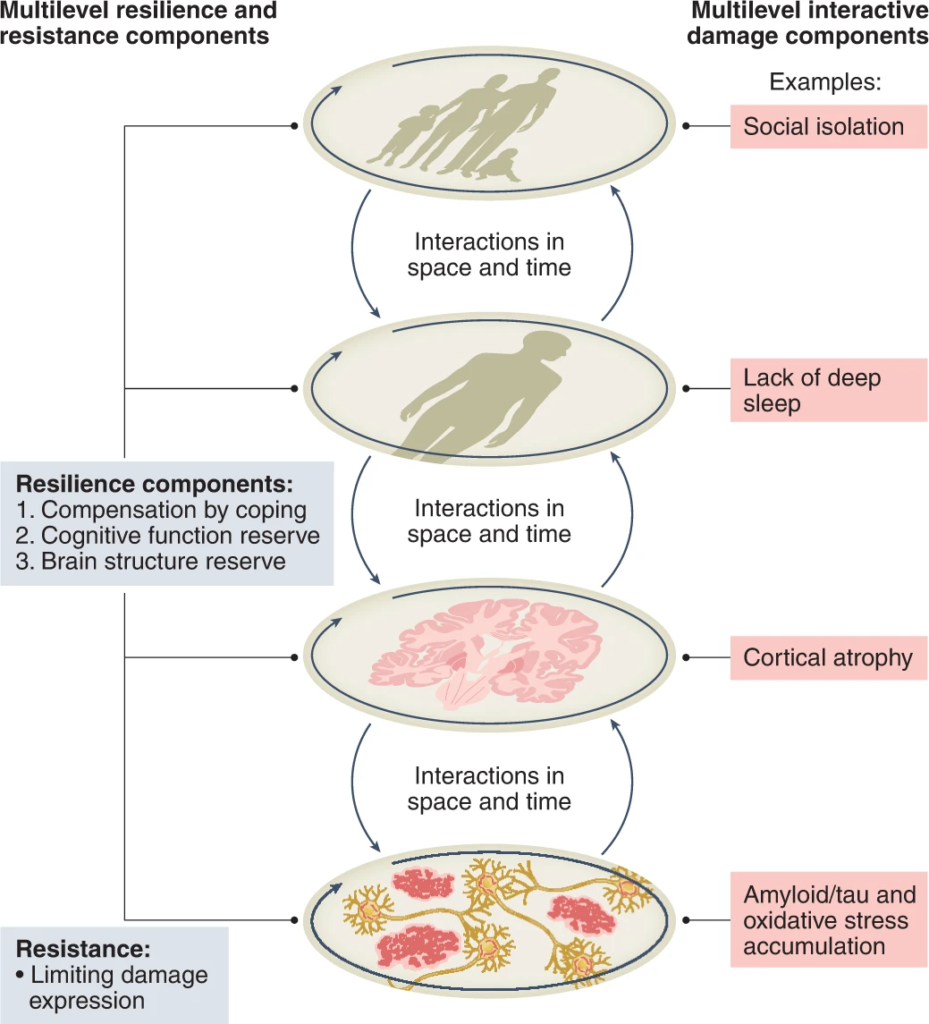
A complex systems approach to aging biology (Cohen et al 2022)
One of the additional challenges at the center of aging is that the body is resilient and maintains homeostasis for many decades. Our physiology possesses multiple paths to support homeostasis and maintain stable traditional biomarkers, like blood tests. Unfortunately, it’s not until late in life that the ravages of aging become apparent as key physiological systems start to collapse.
The body is constantly adapting to the aging process, with some changes being beneficial and others not. Knowing when and where to intervene with treatments is crucial.
Practically speaking, the complexity of aging makes it challenging to develop effective longevity interventions, as the timing, target, and approach need to be carefully considered for each individual and their specific aging profile.
???????? What To Consider ????:
- ???? Type: Consider if your best approach is a Supplement vs. Small Molecule Drug vs. Biologic
- ???? Delivery mechanism: What is your preferred delivery method (Oral vs. Injectable vs. Topical vs. Intranasal) and is it effective and bioavailable?
- ⏰ Timing & Dose: Fixed Dose vs. Personalized & Adaptive Depending on approach, consider How long is appropriate, and what cycling is necessary?
Tracking Efficacy of Human Aging Treatments – Which Biomarkers?
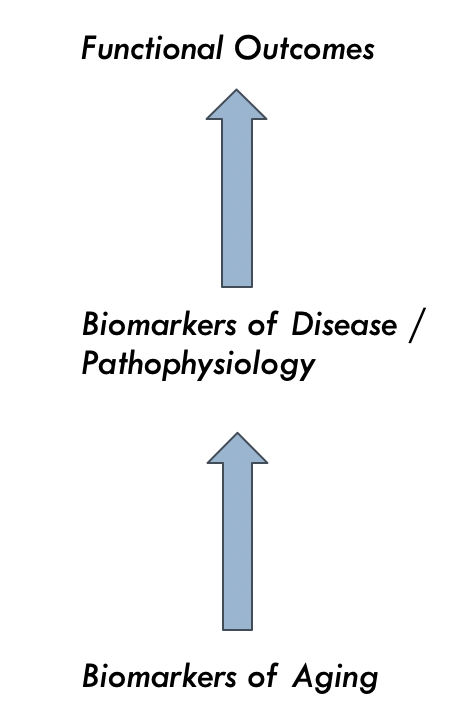
Functional measures and traditional blood-based biomarker have become the de-facto standard approach to measuring health, wellness and, to a limited extent, longevity. Unfortunately, because we often see functional changes suddenly and at the late stage of aging, they are not particularly suited for measuring and optimizing a longevity treatment strategy. Instead, Brooke noted that molecular biomarkers like epigenetic clocks are particularly valuable as they can detect changes earlier in the aging process compared to functional measures.
Because aging plays out at multiple levels (molecular, cellular, tissue, and organ system levels), and ultimately leads to functional decline and death. Each of these levels undergoes changes with aging that need to be considered. This leads to an essential question related to which biomarkers to track and when?
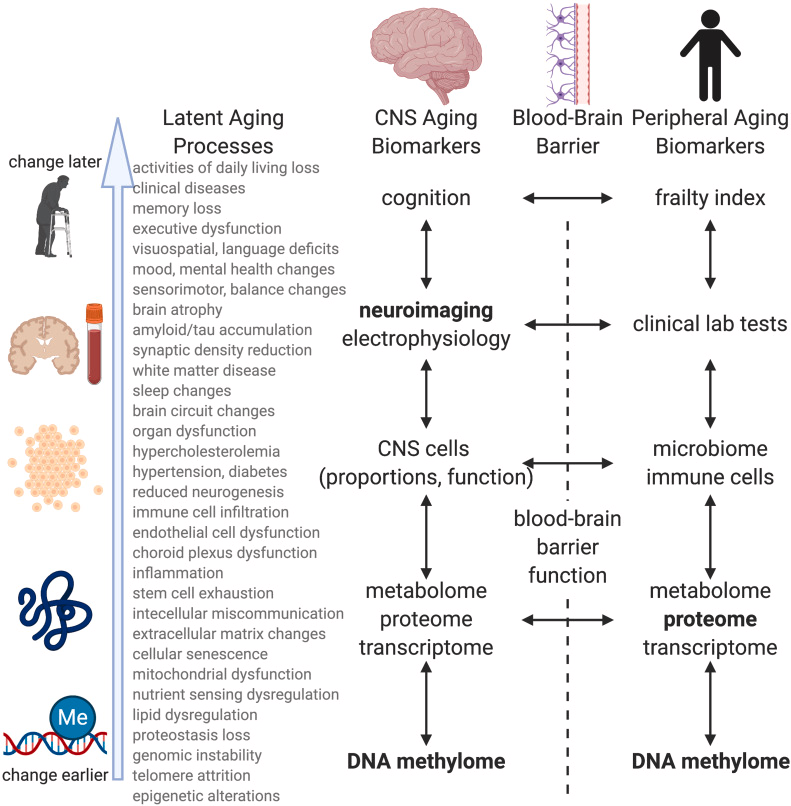
Source: Aging biomarkers and the brain (Higgins-Chen 2021).
Brooke discussed the different types of biomarkers that can be used to evaluate the effectiveness of longevity interventions:
- Biomarkers of aging biology or aging hallmarks, such as epigenetic clocks and telomere length, which directly measure aspects of the aging process.
- Disease biomarkers that track the risk or progression of age-related diseases, like cardiovascular disease or cognitive decline.
- Functional outcome measures that assess physical and cognitive performance, which can be challenging to use in younger populations due to a ceiling effect.
Brooke emphasized the importance of using a combination of these different biomarker types to get a comprehensive understanding of how a longevity treatment is impacting the aging process and downstream health outcomes. Overall, Brooke stressed the need for a multi-faceted approach to evaluating the efficacy of longevity interventions.
???????? What To Consider ????:
- ???? Biomarkers of Aging: Consider biomarker and biological age tests that measure beyond traditional biomarkers and function, like epigenetic, telomere and hallmarks of aging.
- ???? Disease Biomarker: If you have a family history of a disease, an early indicator from a broader screening test or GrimAge risk factor, consider specific testing for disease detection and prevention.
Does a Shotgun Approach Make Sense?
The shotgun approach has become increasingly popular longevity intervention. This method involves combining multiple potential anti-aging agents into a single protocol. Examples include Blueprint Protocol by Bryan Johnson and Bredesen/MIND Protocol for Reversal of Cognitive Decline. Brooke listed several limitations:
- Even relatively popular agents like metformin can have significant negative interactions with other treatments
- Tend to be one-size-fits-all, when individuals have very different responses to drug metabolism between them and over time with aging
- Any evidence they actually work?
- Poor compliance
Schematic Example of complex drug interactions
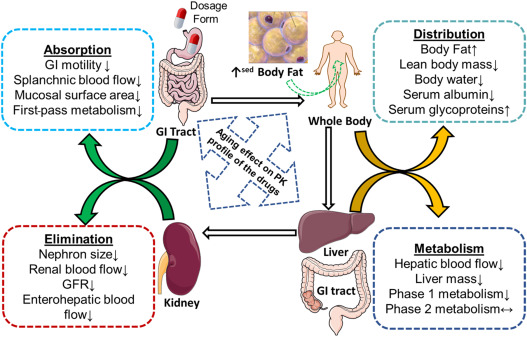
Source: Impact of ageing on the pharmacokinetics and pharmacodynamics of the drugs (Polaka et al 2022)
Monotherapy vs Shotgun vs. Combination Approaches
What are the key advantages and disadvantages of each of these three approaches to longevity interventions?
In discussing different approaches to longevity interventions, Bobby Brooke contrasts three main strategies: monotherapy, shotgun, and combination approaches.
- The monotherapy approach focuses on testing and evaluating the effects of a single agent or treatment. This allows for a more targeted and controlled evaluation of the intervention.
- In contrast, the shotgun approach involves taking a large number of different supplements and treatments at once in a “throw everything at the wall and see what sticks” manner. Brooke notes this approach is problematic due to poor compliance, difficulty studying it scientifically, and potential negative interactions between the various agents.
- The combination approach aims to develop and test rational combinations of different longevity treatments that are selected based on their complementary effects on aging biology, functional benefits, and disease biomarkers. This approach seeks to maximize the synergistic benefits of the interventions while minimizing potential negative interactions.
Longevity Groups: Patient-Led Targeted Combination for Promising Longevity Interventions Available Today
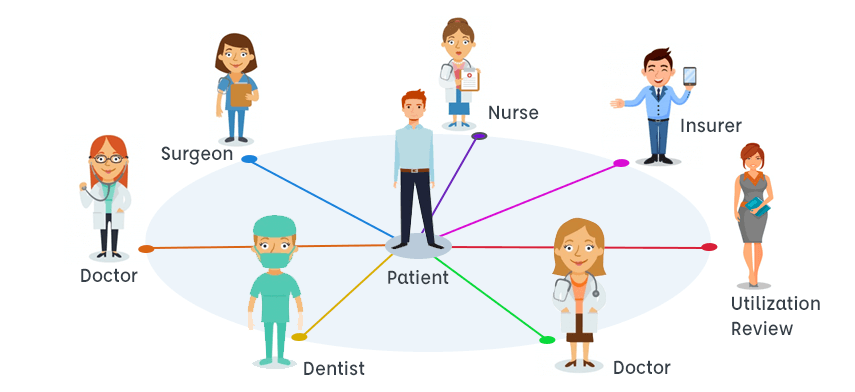
In lieu of difficulties and limitations associated with monotherapy, shotgun and even large scale trials, the Clock Foundation / MyAgingTests.com recently launched our Longevity Groups initiative, which Brooke and Mark Koester helped to establish and launch. The approach is patient-led, patient-centric and is based on a combination approach.
Key Principle: Patient-led / Patient-centric
- Personalized treatments
- Use of combinations is okay
- Adapting treatment is okay
Pitfalls: Why not test a monotherapy?
- Complex diseases require multi-targeted approaches
This approach allows for a more targeted and evidence-based evaluation of longevity interventions and enables participants to maximize their benefit across different open enrollment study groups.
Longevity groups are focused on optimizing results for participants rather than studying the effects of individual drugs. We are non-profit research group, not a drug company.
Our Solution: Targeted Combination Groups

Brooke emphasizes the importance of taking a rational, evidence-based approach to combining different longevity interventions, rather than just throwing many supplements together.
In view of the availablity of researcher-grade epigenetic age tests like GrimAge and a host of potential and longevity interventions, the Clock Foundation and MyAgingTests.com are excited to be establishing a series of targeted combination groups that will test specific combinations of longevity treatments, rather than a broad “shotgun” approach.
AVAILABLE NOW: You can join our first alpha-ketoglutarate (AKG) group.
Example Treatment Options (Work-in-Progress):
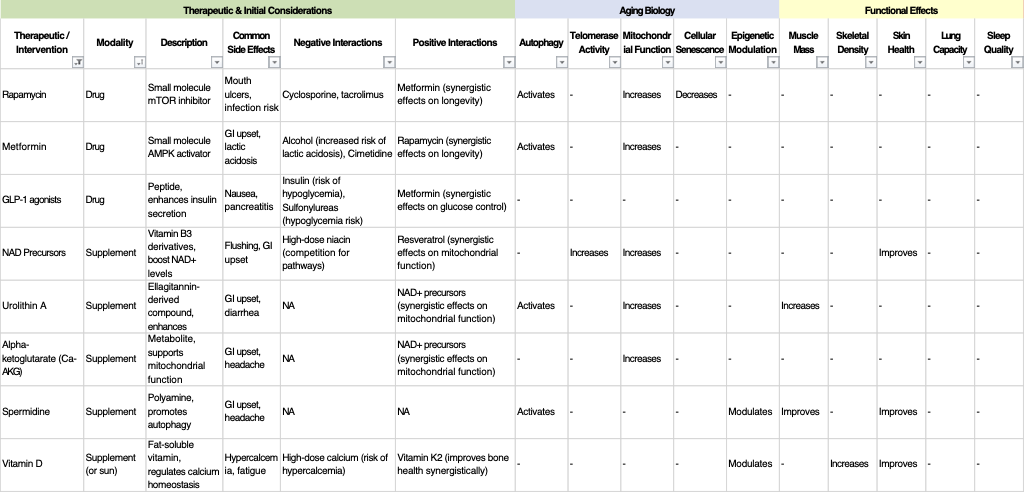
In the coming months, the team plans to to launch 10 or more additional AKG+ groups, each targeting a different set of grim age risk factors, such as:
- brain health
- metabolic health
- vascular health
- etc.
The goal is to allow participants to shift between these targeted groups over time according their aging testing and as they optimize their personalized longevity treatment regimen.
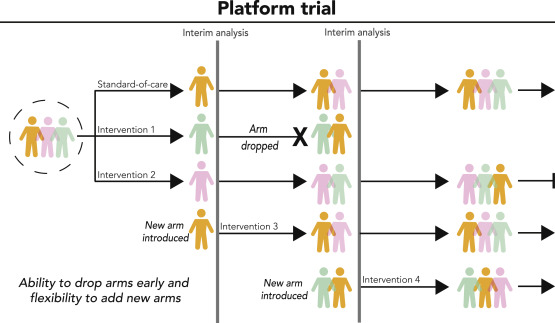
An overview of platform trials with a checklist for clinical readers (Park et al 2020.)
By focusing on targeted combinations, the groups aim to maximize the synergistic benefits of the interventions while minimizing potential negative interactions. In turn, we can all learn the benefits of different anti-aging interventions holistically on biological age and their targetted impact on specific aging risk factors, like PAI-1 and others.
Benefits include:
- Longevity Groups are Personalized Based on Initial Test Results
- Lower Cost of Participation
NOTE: Eligibility only dependent on initial test like GrimAge & completion of Longevity Actions Survey
By focusing on targeted combinations, the groups aim to maximize the synergistic benefits of the interventions while minimizing potential negative interactions.
What Longevity Actions are you Taking?
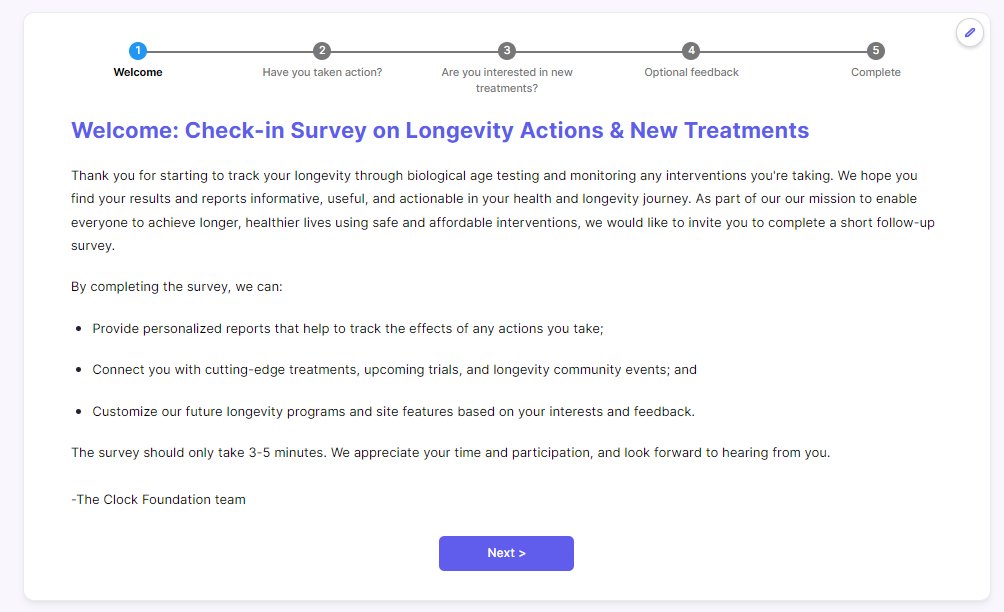
Beyond biological age testing, a key component in our approach to anti-aging and creating empowering longevity plans is tracking what you are doing. Our “Longevity Actions Survey” is designed to be a simple next step for people after they have obtained their epigenetic test results, such as their GrimAge or PhenoAge.
By completing the Longevity Action Survey, people can indicate what interventions they are planning to take and get more direction on what to do next. The survey helps lower the barrier to entry for people to participate in the targeted longevity intervention groups that the organization is launching too.
In short, the goal is to make the process of getting involved in these groups and their associated longevity actions and therapies as convenient and straightforward as possible for participants.
Discussion:
In addition to the main talk, there was a lively chat and a number of insightful comments from the event. Here are a few notable points:
Hormetic Interventions:
- Hormetic interventions involve exposing the body to a mild stressor that then catalyzes endogenous regenerative and repair mechanisms. This is also a potentially beneficial category of interventions to pursue.
Metformin:
- Metformin is one of the safer and more popular putative longevity agents. Unfortunately new evidences points out that it can have negative interactions with other treatments, like exercise.
NAD precursors:
- NAD precursors like NR (nicotinamide riboside) and NMN (nicotinamide mononucleotide) have received a lot of attention as potential longevity supplements.
- Brooke acknowledged that assessing the bioavailability and effectiveness of different NAD precursors can be challenging, as many of the common blood-based NAD assays are not very reliable.
- While the different NAD precursors may have slightly different effects, overall they seem to provide some degree of improvement in NAD levels and related benefits, though the optimal formulation is still being researched.
- Brooke expressed that more rigorous clinical data is still needed to fully understand the longevity impacts of NAD precursor supplementation.
Benefits of different fasting regimens for longevity
- The more dramatic results in preclinical studies have been seen with 48-72 hour fasting periods, where there are benefits like immune system improvements that may be driven by a hormetic effect.
- However, there are also recent studies showing that the ketosis and inflammation caused by fasting can have negative impacts that need to be considered.
- Brooke noted that he is not aware of many direct comparisons between 16-hour intermittent fasting and 24-hour fasting regimens in terms of their longevity effects.
- Overall, Brooke indicated that the jury is still out on the optimal fasting approach for longevity, and more research is needed to fully understand the tradeoffs and benefits of different fasting protocols.
Pharmacological Interaction Checkers:
- Online pharmacological interaction checkers help assess potential interactions between different drugs and longevity treatments, and this would be a valuable tool to integrate into the MyAgingTests.com Longevity Tracker Site.
Overall, the community discussion touched on several additional nuances and considerations around evaluating and implementing longevity interventions in a safe and effective manner.
Longevity Research Review & Recap
In the monthly recap section, Bobby Brooke discussed the latest research and developments in the field of longevity that the Clock Foundation has been tracking. The goal of these monthly recaps is to make sense of the large volume of literature that comes out each month, with a particular focus on new information about treatments, supplements, and medications that are available and actionable for people today.
⏰ Review of Epigenetic Clock Data Papers
- Mendelian Randomization Study showed that GrimAge and Horvath Epigenetic Clock acceleration did increase risk of late-onset AD
- This longitudinal study investigated whether DNA methylation mediates the relationship between cardiometabolic risk factors and cognitive function in 3,708 older adults. Results showed that DNA methylation significantly mediated the impact of hypertension, diabetes, and obesity on cognitive decline, highlighting its potential as a target for dementia prevention.
- This study examined how well two measures of aging, PC-GrimAge and DunedinPACE (PACE), predicted health outcomes in 278 middle-aged African American adults. The results showed that PC-GrimAge could be mostly predicted by basic factors like age, sex, smoking, and drinking, while PACE was better predicted by factors related to heart health. This suggests that these aging measures provide different health information and may have limitations in guiding patient care.
- Notable: “The addition of other serological, demographic, and medical history variables or PACE values did not meaningfully improve the prediction”
- Why “phenotypically-trained” is not very helpful – can miss the point entirely?

- This study from Brian Kennedy’s group looked at a new composite measure of aging that includes around 50 different tests.
- The composite measure was able to predict future health outcomes better than just using basic survey measures.
- When testing the effects of ACE inhibitor drugs on this composite aging measure, the researchers found the drugs had a positive impact, improving the aging measure.
- However, Brooke noted that this composite measure using principal components was harder to interpret than simpler biomarkers like epigenetic clocks. This made it more difficult to tie specific interventions to improvements in particular risk factors.
An expedited screening platform for the discovery of anti-ageing compounds in vitro and in vivo
- Applies to primary cells in culture
Mechanisms of Aging Review
Human Brain Aging is Associated with Dysregulation of Cell-Type Epigenetic Identity
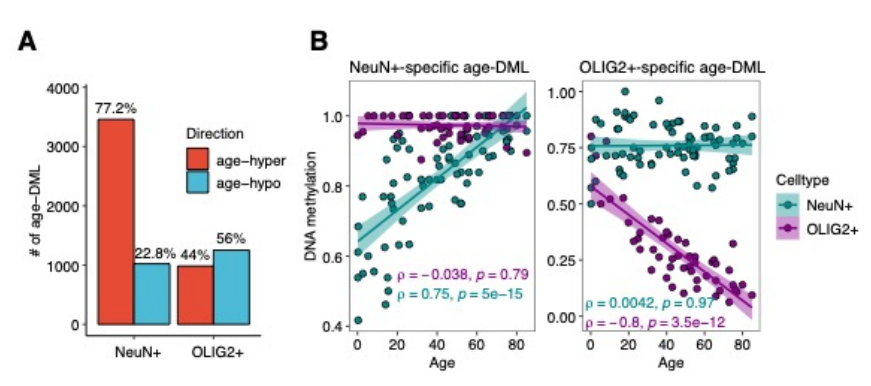
- This preprint study used whole-genome bisulfite sequencing to examine epigenetic changes in the human brain during aging.
- It howed that there is this kind of dysregulation of cellular state, or cellular identity as as you age.
- The researchers found that neurons and glial cells age very differently, with distinct epigenetic changes occurring in each cell type.
- This suggests that treatments may need to be tailored specifically to the cell type and tissue being targeted.
PRC2-AgeIndex as a universal biomarker of aging and rejuvenation

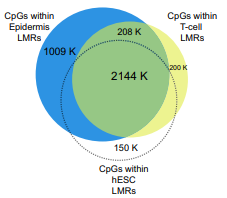
- Universal Biomarker of Aging and Rejuvenation? This study identified a set of methylation sites that are conserved across cell types and represent a “universal” measure of stemness and aging.
- “We then propose the PRC2-AgeIndex as a biologically informed approach to measure aging, based on the progressive gain of DNAm at LMRs which are highly bound by PRC2 (High-PRC2 LMRs) in human embryonic stem cells (hESCs) genome-wide mostly mapping on developmental genes…”
- PRC2 targets gain DNA methylation by cell division…We estimated that this epigenetic change represents around 90% of the age-dependent DNAm gain genome-wide.
- Treatments like the Yamanaka factors, caloric restriction, and fasting were able to rejuvenate this universal aging biomarker.
- This provides insight into fundamental mechanisms of aging that could be targeted by longevity interventions.
A few other noted papers included:
- Transcriptomic Hallmarks of Mortality Reveal Universal and Specific Mechanisms of Aging, Chronic Disease, and Rejuvenation
- Integrative epigenetics and transcriptomics identify aging genes in human blood
- Epigenetic and proteomic signatures associate with clonal hematopoiesis expansion rate
???? Treatment News – ???? Rodent and Animal Models
Inhibition of IL-11 signalling extends mammalian healthspan and lifespan
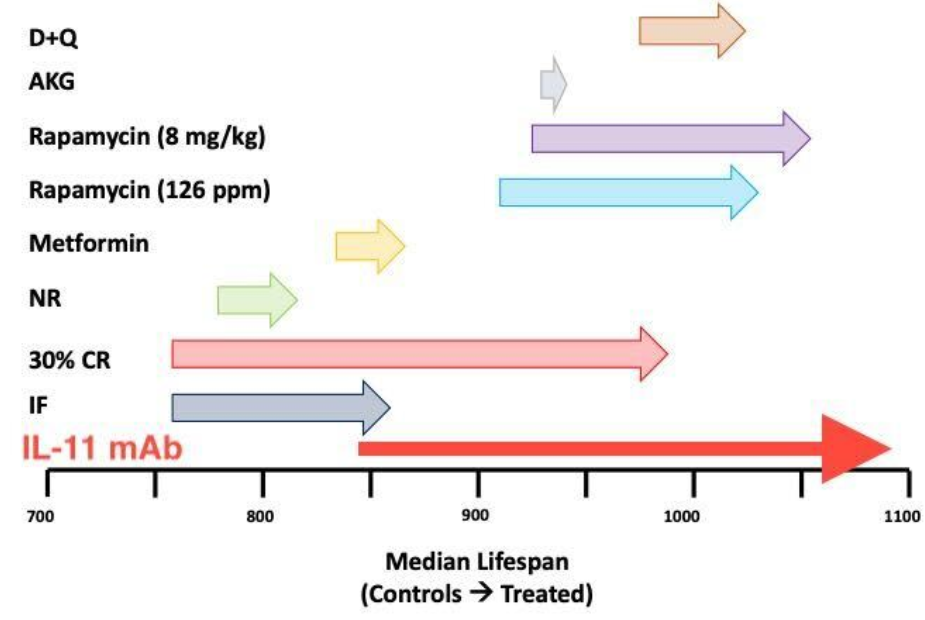
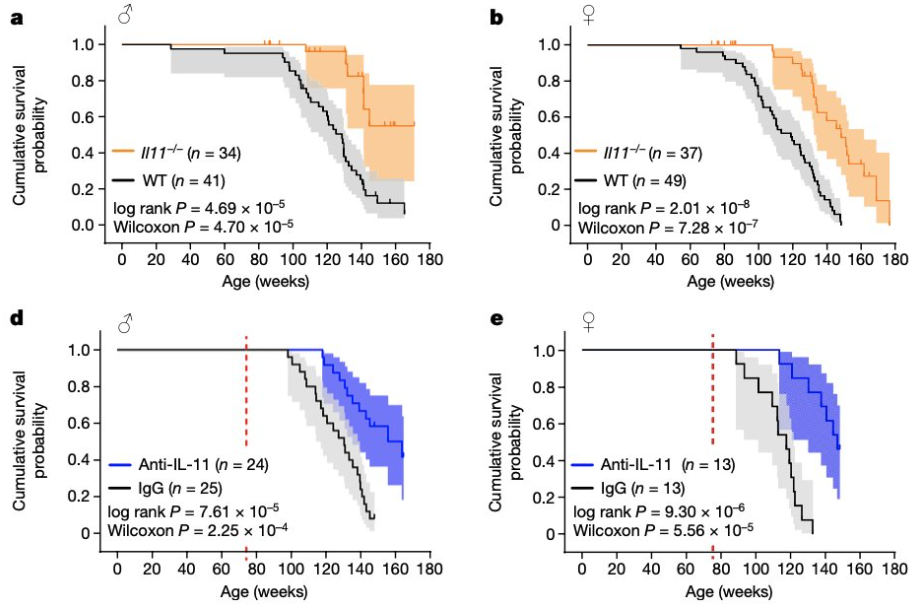
- ‘Supermodel granny’ drug extends life in animals – This study looked at the effects of inhibiting the inflammatory cytokine IL-11 on lifespan in mice.
- IL-11 is a pro-inflammatory cytokine related to IL-6, which has been a target of interest for longevity research.
- The study found that using an antibody to inhibit IL-11 significantly extended lifespan in mice, with an effect comparable to 30% caloric restriction and greater than the effects seen with rapamycin.
- Brooke noted that while there are currently no approved pharmaceutical treatments targeting IL-11 available, there are drug companies developing IL-11 monoclonal antibodies that may eventually be tested for longevity applications.
- Overall, the study on IL-11 inhibition provided promising preclinical evidence for targeting this inflammatory pathway as a potential longevity intervention.
Other papers:
- Cognitive rejuvenation in old rats by hippocampal OSKM gene therapy
- Programming tumor evolution with selection gene drives to proactively combat drug resistance
- A maternal brain hormone that builds bone
- Our findings establish CCN3 as a potentially new therapeutic osteoanabolic hormone for both sexes and define a new maternal brain hormone for ensuring species survival in mammals.
- Empagliflozin rescues lifespan and liver senescence in naturally aged mice
- Targeting senescence induced by age or chemotherapy with a polyphenol-rich natural extract improves longevity and healthspan in mice
TERT activation targets DNA methylation and multiple aging hallmarks
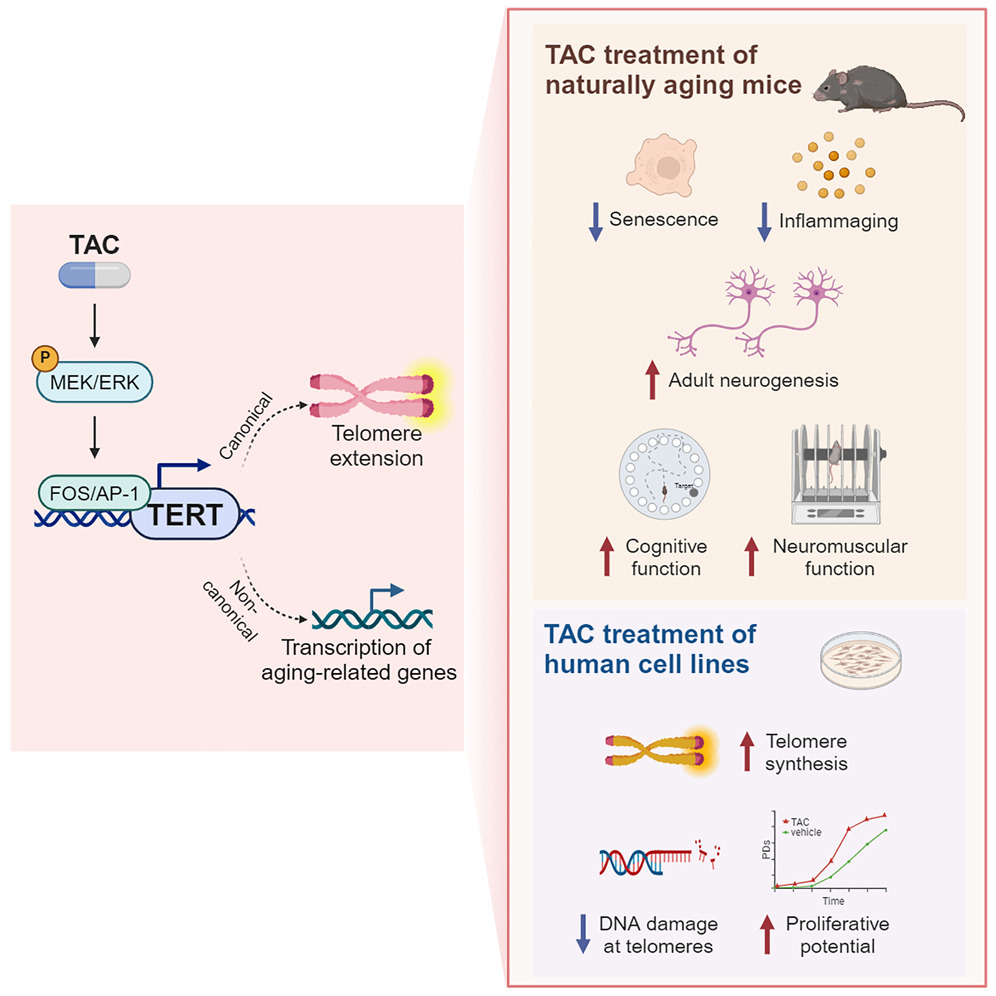
- This study looked at a new telomerase activator compound.
- Telomere length and telomerase activity are considered important hallmarks of the aging process, so treatments that can activate telomerase are of interest for longevity.
- This study was conducted by an experienced group of drug developers, suggesting the compound may have a better chance of progressing through clinical development compared to some previous telomerase activators.
- “…we conducted a high-throughput screen through a library of approximately 653,000 compounds using mouse cells transgenic for the human TERT locus harboring a luciferase reporter…”
- In mouse studies, this telomerase activator showed promising effects on lifespan, comparable to or better than some other well-known longevity interventions like rapamycin.
- Brooke noted that activating telomerase is a tricky therapeutic approach due to the potential cancer risks, but this study represents an interesting new development in this area of longevity research.
Programming tumor evolution with selection gene drives to proactively combat drug resistance
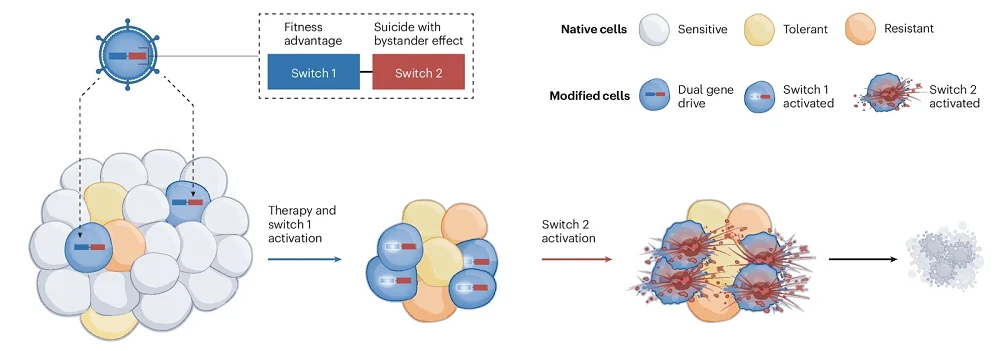
- Lifespan.io Scientists Eliminate Cancer Using Evolutionary Principles-
- This study looked at a novel cancer treatment approach that utilizes a viral vector with a “suicide switch” mechanism.
- This treatment involves using a viral vector to provide a fitness advantage to tumor cells, but then also includes a built-in suicide switch that can eliminate those cells.
- Brooke found this to be a very innovative approach, as the bystander effect of the suicide switch also appears to eliminate other resistant tumor cells.
- “It not only kills the engineered cells, but it also kills the surrounding cells, namely the native resistant population,” said Justin Pritchard, associate professor of biomedical engineering and senior author on the paper. “That’s critical. That’s the population you want to get rid of so that the tumor doesn’t grow back.”
- While this was just a rodent study, Brooke considered it a promising development in cancer treatment that could have implications for longevity by targeting a major age-related disease. – He highlighted the creativity and experience of the research team behind this approach as a positive sign for its potential to progress further in development.
???????? Neuron-type specific aging-rate reveals age decelerating interventions preventing neurodegeneration
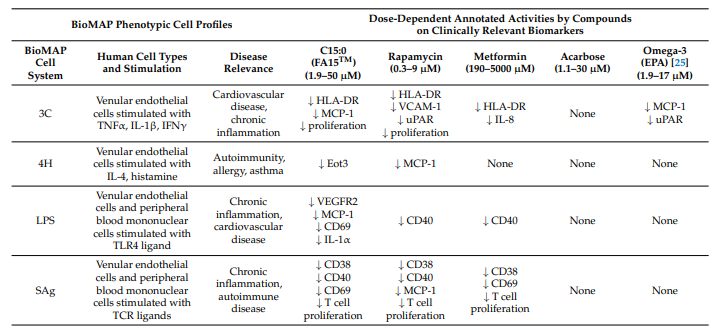
- This was a study on the compound C15 that was conducted in worms.
- The study looked at the effects of C15 in cell culture assays using the BioMAP platform, which tests compounds across 20 different cell-based assays.
- Pentadecanoic Acid (C15:0), an Essential Fatty Acid, Shares Clinically Relevant Cell-Based Activities with Leading Longevity-Enhancing Compounds (Rapamycin)
- The researchers found that C15 had a very similar profile to rapamycin in these cell-based assays, suggesting it may share some of the same mechanisms of action.
- “syringic acid and… vanoxerine… could serve as neuroprotective interventions”
- However, Brooke noted that the clinical data available on C15 so far is quite limited, with the trials mostly focused on disease populations rather than healthy individuals.
- Overall, the cell culture data was intriguing, but Brooke indicated the clinical evidence for C15 as a longevity intervention is still quite modest at this point.
????Treatment News –????Human Trials
The clinical trials included in this month’s recap mostly targeted diseases. Here were the papers:
- Nicotinamide riboside for peripheral artery disease: the NICE randomized clinical trial
- Probiotic-Reduced Inflammaging in Older Adults: A Randomized, Double-Blind, Placebo-Controlled Trial
???? Influencer & Initiative Updates????
- Bryan Johnson’s Blueprint – Blueprint Stack launched
- XPRIZE Foundation – August team meeting in Copenhagen
- The XPrize Foundation has launched a $101 million Healthspan Prize competition.
- The XPrize Healthspan Prize is focused on improving healthspan, or the period of life spent in good health, based on functional outcomes and other measures.
- The XPrize team is holding a team meeting in August at the ARDD Conference in Copenhagen to discuss the progress and plans for this longevity-focused prize competition.
- Brooke highlighted the XPrize Healthspan Prize as an important initiative in the longevity field that is aiming to drive innovation and progress in improving human healthspan.
- Peter Attia, a physician and researcher who focuses a lot on disease prevention and physical fitness, shared his exercise recommendations for older individuals. While many longevity interventions were discussed during, exercise should not be forgotten as it can have profound effects, even though compliance can be challenging.
- Brooke cited a post from David Sinclair showing that even with a structured exercise program, only 30% of participants were able to adhere to it at 12 months, highlighting the difficulty of maintaining exercise regimens.

